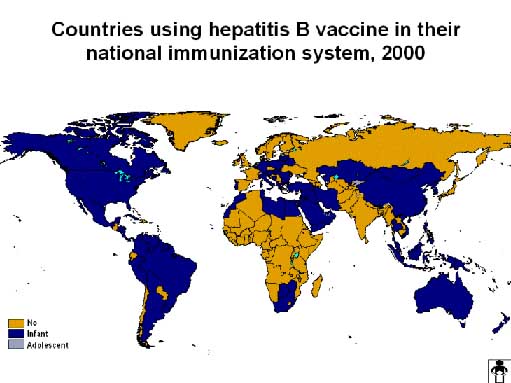![]() Hepatitis
B
Hepatitis
B ![]()
Background
The hepatitis B virus (HBV) is a very under-appreciated major health problem not only in the United States, but worldwide. Hepatitis is an inflammation of the liver. Part of the reason hepatitis B is so under-appreciated is that often times, it causes mild or even no disease symptomology with an acute infection. Symptoms which do occur, when present, include fatigue, loss of appetite, fever, jaundice, nausea, and dark urine. It has been shown that the older people are, the more likely they are to experience symptoms. However, what makes HBV such a major health problem is not the acute infections and consequent symptoms. In about 5-10% of infections, adults fail to clear the virus from the liver, and these people become chronically infected. The older people are, the more likely they are to clear the virus following an acute infection.
Eighty percent of infants become chronic carriers if infected, while the percentage for adults is less than 10%. Those who are chronically infected are often asymptomatic. While the 5 year survival of chronically infected patients is very high, the long term prognosis often is not as promising. Chronic carriers are at increased risk of liver diseases such as cirrhosis and liver cancer. Studies in Taiwan have shown that the risk of liver cancer is almost 200 times higher in people with HBV than those without it (Specter, 1999). However, because the effects of HBV are so delayed in life, similar to smoking cigarettes and consequent lung diseases, many people either ignore the potential future threats, or simply choose to believe nothing harmful will come to them. Education is the key to changing this mindset.
Transmission of HBV is very similar to HIV in that it can occur perinatally, through sexual contact, and reuse of needles. Unlike HIV, transmission is also believed to occur through the sharing of household items, like a toothbrush or razors, and also through child to child contact. Although there is not much evidence to support the latter, it is believed to occur when children have skin lesions, which provide a route outside of the body, and have physical contact with other children such as in wrestling. The reason that this is hypothesized to be possible is because HBV is 50-100 times more infectious than HIV (WHO, 1998). Transmission in the United States occurs primarily through sexual contact, while in certain countries in Asia and Africa where prevalence can reach as high as 15-20% of the general population, perinatal transmission is the most common (Kirchner, 2000). There are currently about 300 million people infected worldwide, with 1-1.25 million in the United States. About 1 million people die annually of HBV induced liver diseases (CDC, 1990).
Unfortunately, there currently is no cure for those chronically infected with hepatitis B, and the cost for treating cirrhosis and liver cancer is very expensive, if not entirely effective. However, with the discovery of a vaccine for HBV, it has become an entirely preventable disease for those who are still susceptible. The vaccine for HBV is a 3 series intramuscular immunization that is 80-95% effective. There are no known side effects for the vaccine, and no apparent risk to the fetus of a pregnant woman (CDC, 1990). As with all vaccines, costs are an important issue if control and implementation are to be considered. Vaccinating an infant for HBV costs about the same as other childhood vaccines. The costs for adolescents and adults however are much more expensive due to higher implementation costs as well as costs of delivering the vaccine to high risk target populations.
Despite this, it has been shown repeatedly when looking at a population as a whole that initially, giving everyone the vaccine costs a large amount of money. For children, costs are about $200+ while for adults its $300+. However, as with many other types of vaccines given to the public in general, it is a worthwhile investment and in the long run, will save lots of money in the future. Costs of treating those with liver cancer or cirrhosis could costs upwards of thousands, which is not just a one time cost, but often must be paid repeatedly (Henderson, 2000). In Taiwan, where nationwide vaccination of infants and children has already been implemented, studies have shown a decline of 90% of hepatitis B cases, which could potentially translate into a 90% decline in HBV induced liver diseases, thus saving lots of money in the future (Seppa , 1997).
Many states have recognized these potential savings and benefits to the public and have recommended prenatal testing of pregnant women as well as vaccination of high risk adults and adolescents. Many states have also implemented programs requiring childhood vaccinations and mandatory immunization prior to 7th grade enrollment (Blevins, 1999). However, these programs alone will not help everyone. They leave many people out, such as those who have already passed 7th grade after implementation of the program. Also, what about those infants born after mandatory vaccinations, but still not yet in 7th grade? What about immigrants coming to the United States from countries which do not require HBV vaccination? With all of these potentially susceptible groups still not targeted, additional programs other than those currently implemented must be done. That is why people must be educated about this disease so that they are made aware of the necessary preventative measures available, namely the vaccine. Without this awareness, only those people who are required by law to be vaccinated will be protected, leaving those unaware of the situation still at risk. Below is a map showing which countries include hepatitis B in their immunization programs.

©2001
Disclaimer-Please note that this website was
made for the purposes of a class.
For comments or questions, e-mail me at jasers24@aol.com.